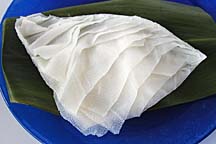
Eleanor Nakama-Mitsunaga
![]()
|
This ingredient, like other innards, has no middle ground -- you like it or you don't. Tripe has been described as chewy and delectable or rubbery, bland and inedible. Yet throughout Europe and Asia, tripe consumption has a history that dates back centuries.
The basics: Tripe is the muscular lining of the stomach of either beef, pork or sheep, but beef is the most available and desired.
Tripe is processed from various stomach chambers, each of which yields a number of different kinds of tripe. The most prized type is honeycomb tripe, which comes from the second stomach chamber.
The inner side has a distinctive honeycomb design and the tripe itself is the most tender and meaty. The less desired tripe, from the first stomach, is called flat or smooth tripe and is tougher to consume. Once in awhile stores carry leaf tripe, which is very thin with small bumps.
All tripe is generally pre-cooked, because fresh tripe would have to cook approximately 12 hours to be palatable. Most tripe is also bleached for a aesthetic appeal. Unbleached tripe has a unappetizing, dull, grayish hue.
Tripe in general has a subtle flavor and is more desired for its chewy texture. It is hard to digest, however, and should be avoided by people with gout or indigestion problems.
Selecting: Choose tripe with a uniform, pale, off-white color and no blotchy yellow spots. Use honeycomb tripe whenever possible.
Storing: Tripe should be used as soon as purchased or stored in the refrigerator for only a day or two. Fresh tripe can be frozen, but most tripe available in markets has been previously frozen and should not be frozen again.
Use: Even precooked tripe requires a long simmering time, so it is most often used in stews, soups and braised dishes. The ideal cooking time is about two hours. Tripe should be thoroughly rinsed and dried. Some stew recipes call for massaging in baking soda as tenderizer.
Locally, tripe is most often used in tripe stew. Other popular dishes include, menudo -- a Mexican tripe soup with onions, hominy and chili spices; French braised tripe with carrots, onions and cider; and Chinese stir-fried tripe with chilies, fresh coriander and ginger. Tripe is also pickled.
Where to buy: Tripe is available in most supermarkets year-round in the fresh beef section. Prices range from $2 to $5 a pound, depending on type -- honeycomb being the most expensive.
Eleanor Nakama-Mitsunaga is
a free-lance food writer. Contact her
online through features@starbulletin.com


